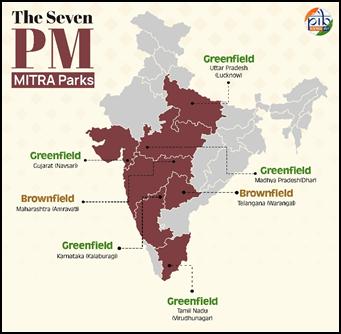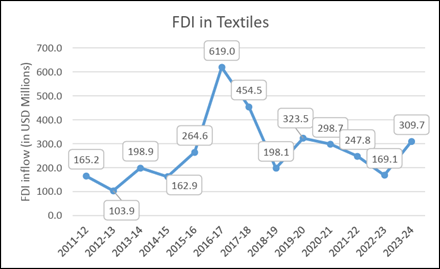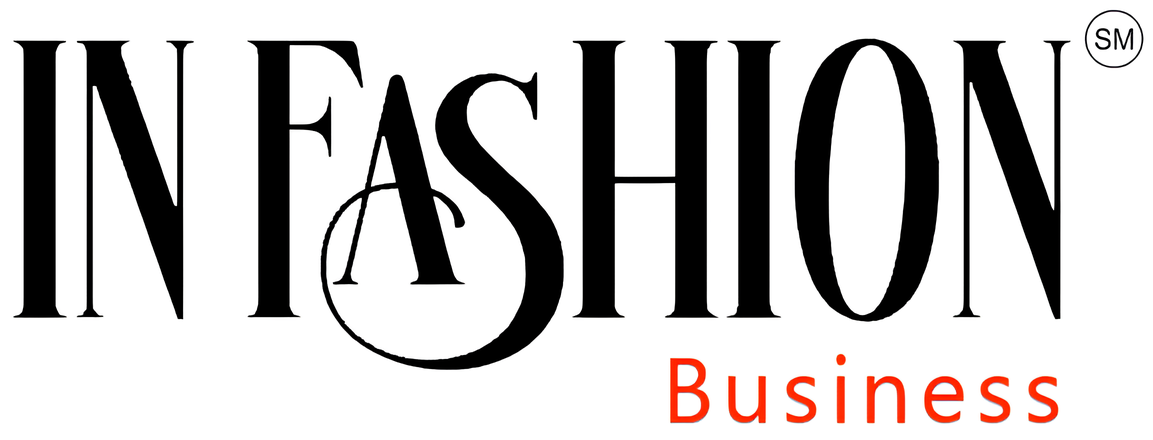MADE IN INDIA TEXTILES APPAREL NATIONAL
NEW DELHI, INDIA
By IFAB MEDIA - NEWS BUREAU - April 2, 2025 | 472 30 minutes read
Introduction
The Make in India initiative, launched in 2014, has played a crucial role in positioning India as a global textile manufacturing and export hub. The textile and apparel industry is one of the largest contributors to India’s economy, providing employment to millions and generating substantial foreign exchange earnings. With strong policy support, infrastructure development, and a skilled workforce, India has emerged as a preferred investment destination in the global textile sector.
Overview of India's Textile Industry
The textile and apparel industry contributes 2.3% to our GDP, 13% to industrial production, and 12% to exports. India exported textile items worth US$ 34.4 billion in 2023-24, with apparel constituting 42% of the export basket, followed by raw materials/semi-finished materials at 34% and finished non-apparel goods at 30%. It is also the second largest employment generators, after agriculture, with over 45 million people employed directly, including many women and the rural population. As further evidence of the inclusive nature of this industry, nearly 80% of its capacity is spread across Micro, Small and Medium Enterprises (MSME) clusters in the country.
The sector also has perfect alignment with the Government’s overall objectives of Make in India, Skill India, Women’s Empowerment, Rural Youth Employment and inclusive growth. The industry produces about 22,000 million pieces of garments per year, with the market size projected to reach US$ 350 billion by 2030, from the current $174 billion.
Recently, the Ministry of Textiles reported a 7% increase in textile and apparel exports, including handicrafts, from April to December 2024, compared to the same period the previous year. In line with the growth roadmap, the Indian textile market currently ranks fifth globally, and the government is actively working to accelerate this growth to a rate of 15-20% over the next five years.
Impact of 'Make in India' on the Textile Industry
The Make in India initiative has catalyzed textile manufacturing and exports through key policy interventions, enhanced infrastructure, and incentives. In the Union Budget 2024-25, to promote domestic textile production, two more types of shuttle-less looms are added to fully exempted textile machinery by the government. The government has introduced multiple schemes to enhance textile production, boost investments, and promote exports, including:
- Production Linked Incentive (PLI) Scheme for Textiles
- Objective: To increase manufacturing in man-made fibre (MMF) and technical textiles.
- Budget: ₹10,683 crore.
- Incentives: Financial incentives for large-scale textile manufacturers.
- PM MITRA (Mega Integrated Textile Region and Apparel) Parks

- Objective: To develop world-class industrial infrastructure for textile manufacturing.
- Focus: On developing integrated large scale and modern industrial infrastructure facility for total value-chain of the textile industry like spinning, weaving, processing, garmenting, textile manufacturing, processing & textile machinery industry.
- Budget: ₹4,445 crore for a period 2021-22 to 2027-28.
- Key Benefits: Reduced logistics costs, increased FDI, and better competitiveness in global markets.
- Current Status: A total of 7 Parks established in states of Gujarat, Maharashtra, Madhya Pradesh, Tamil Nadu, Karnataka, Uttar Pradesh, and Telangana.
- Amended Technology Upgradation Fund Scheme (ATUFS)
- Objective: To incentivise credit flow for benchmark credit linked technology upgradation in this MSME driven Textile Industry for supporting capital investment.
- Budget: ₹17,822 crore.
- Incentives: Capital subsidies for technology upgradation.
- Samarth (Scheme for Capacity Building in Textile Sector)
- Objective: To provide skill training to workers in the textile industry, in partnership with the Ministry of Skill Development & Entrepreneurship.
- Budget Allocation: An amount of ₹115 crores was sanctioned during the FY 2023-24, out of which ₹114.99 crores (99.9%) were disbursed.
- Current Status: As of March 27, 2025, more than 4.78 lakh users have been registered on the Samarth portal. As on March 19, 2025, a total of 3.82 lakh beneficiaries have been trained (passed) and 2.97 lakh beneficiaries (77.74%) have been placed.
- Textile Cluster Development Scheme (TCDS)
- Objective: To create an integrated workspace and linkages-based ecosystem for existing as well as potential textile units/clusters to make them operationally and financially viable.
- Benefits: Cluster development model of TCDS will bring benefits of critical mass for customization of interventions, economies of scale in operation, competitiveness in manufacturing, cost efficient, better access to technology and information, etc.
- Budget: ₹853 crore.
- Current Status: As of March 18, 2025, about 1.22 lakh employment opportunities have been generated under the scheme. During 2024-25, ₹34.48 crore have been released.
- National Technical Textiles Mission (NTTM)
- Objective: To boost Technical Textiles in the country.
- Target Years: 2020-21 to 2025-26
- Budget: ₹1480 crore
- Focus: The Mission focuses on (i) research, innovation and development, (ii) promotion and market development (iii) education and skilling and (iv) export promotion in technical textiles to position country as global leader in technical textiles.
- Current Status: As on January 1, 2025, 168 projects of value ₹509 crores (approx.) have been approved in the category of Specialty fibres and Technical Textiles.
Union Budget Allocations for Ministry of Textiles
The Union Budget announced an outlay of ₹5272 crores for the Ministry of Textiles for 2025-26. This is an increase of 19% over budget estimates of 2024-25 (Rs. 4417.03 crore).
Key Highlights
- Cotton Mission: A five-year plan to improve cotton productivity, especially extra-long staple varieties, with science and technology support.
- Tax Exemptions on Looms: Duty removed on select shuttle-less looms to reduce costs and modernize weaving.
- Customs Duty on Knitted Fabrics: Increased from “10% or 20%” to “20% or ₹115 per kg, whichever is higher” to curb cheap imports.
- Handicraft Exports: Time for export extended from six months to one year, with more items eligible for duty-free input imports.
- MSME Boost: Focus on exports, credit enhancement, and policies like the National Manufacturing Mission, Export Promotion Mission, Bharat Trade Net, and Fund of Funds to promote employment and entrepreneurship.
These measures aim to boost domestic manufacturing, support MSMEs, modernize the textile sector, and enhance India's global competitiveness.
Export Growth and Market Expansion

India is the 6th largest exporter of Textiles & Apparel in the world. The share of textile and apparel (T&A) including handicrafts in India’s total exports stands at a significant 8.21% in 2023-24. India has a share of 3.91% of the global trade in textiles and apparel. Major textile and apparel export destinations for India are USA and EU and with around 47% share in total textile and apparel exports. The textile and apparel sector has witnessed significant export growth due to government incentives and trade agreements.
The government has taken several steps to enhance exports in textiles and apparels, including:
- Rebate of State and Central Taxes and Levies (RoSCTL): On 7th March 2019, Government approved Rebate of State and Central Taxes and Levies (RoSCTL) Scheme to rebate all embedded State and Central taxes/levies on export of Apparel/Garments and Made-ups to provide support and enhance competitiveness of these sectors.
- Production Linked Incentive (PLI) Scheme for Textiles: Under this scheme, as per the Quarterly Review Reports (QRRs) released on 31.03.2024, the turnover achieved was Rs. 1,355 crore including export of Rs.166 crore.
- Free Trade Agreements: India has so far signed 14 Free Trade Agreements (FTAs) including recently concluded agreement with United Arab Emirates (UAE), Australia and TEPA (Trade and Economic Partnership Agreement) with EFTA (European Free Trade Association) countries comprising Switzerland, Iceland, Norway & Liechtenstein. India has 6 Preferential Trade Agreements (PTAs) with various trading partners. India is presently engaged in FTA negotiations with some of its trading partners notable among these FTAs are India-UK Free Trade Agreement, India- EU Free Trade Agreement, and India-Oman FTA.
- Quality Control Orders: The Ministry has actively taken up notification of standards for textile products in co-ordination with Bureau of Indian Standards and Quality Control Orders (QCOs) are issued to regulate quality and curb sub-standard imports.
- Textile Advisory Group on Man-Made Fibre (MMF): The Ministry has constituted a “Textile Advisory Group on Man-made Fibre (MMF)” comprising stakeholders of the country’s entire Man-Made Fibre (MMF) including viscose to deliberate and make recommendations on the issues and concerns of the sector.
- Exports Promotion Councils (EPCs): There are eleven Exports Promotion Councils (EPCs) representing various segments of the textiles & apparel value chain from Fibre to finished goods as well as traditional sectors like handloom, handicrafts and carpets. These Councils work in close cooperation with the Ministry of Textiles and other Ministries to promote the growth and export of their respective sectors in global markets.
FDI in Textile and Apparel Industry

Foreign Direct Investment (FDI) plays a role in the Indian textile and apparel sector. From January 2000 to March 2024, the textile sector received US$ 4,472.79 million (₹28,304.10 crore) in FDI equity. FDI in textile sector over the years can be traced in the graph below:
BHARAT TEX 2024
Bharat Tex 2024, a global textile expo was successfully organized during February 26 to February 29, 2024 by the consortium of 11 Textiles Export Promotion Councils with the support of Ministry of Textiles. Built on the twin pillars of trade and investment and with an overarching focus on sustainability, the 4-day event attracted besides policymakers and global CEOs, 3,500 Exhibitors, 3,000 Buyers from 111 Countries and over one lakh trade visitors. An exhibition spread across nearly 2 million sq ft of area and encompassing the entire textile value chain, including an artistically curated story of textiles- Vastra Katha were the highlights of the event. The event was hosted simultaneously at two state of the art venues in Delhi - Bharat Mandapam and Yashobhoomi with both venues fully subscribed.
This global scale conference with 70 sessions and 112 international speakers saw engaging discussions on key textile issues of the day including Textile Mega Trends, Sustainability, resilient global supply chains and Manufacturing 4.0.
BHARAT TEX 2025
Bharat Tex 2025, India's largest global textile event, was successfully organized from February 14 to 17, 2025, at Bharat Mandapam, New Delhi. The event spanned 2.2 million square feet and featured over 5,000 exhibitors, providing a comprehensive showcase of India's textile ecosystem. More than 1,20,000 trade visitors, from 120+ countries including global CEOs, policymakers, and industry leaders, attended the event.
Bharat Tex 2025 served as a platform to accelerate the government's "Farm to Fibre, Fabric, Fashion, and Foreign Markets" vision. India’s textile exports have already reached ₹3 lakh crore, and the goal is to triple this to ₹9 lakh crore by 2030 by strengthening domestic manufacturing and expanding global reach. The event demonstrated India's leadership in the textile sector and its commitment to innovation, sustainability, and global collaboration.
Innovation in Textile Sector
As far as innovation in textiles sector is concerned, Ministry of Textiles has conducted an Innovation Challenges in collaboration with Startup India & DPIIT. In this challenge, 9 winners were recognised and awarded, while incubation opportunities were presented to 6 awardees under the Atal Innovation Mission (AIM). Apart from this, 3 separate innovations challenges were conducted by nature fibre boards on their respective problem statements i.e.
- NJB Technological Innovation Grand Challenge in which 3 winners were recognised and awarded out of 125 applicants.
- CSB Start-up Grand Challenge in which 4 winners were recognised and awarded out of 58 applicants.
- CWDB Wool Innovation Challenge in which 3 winners were recognised and awarded out of 24 applicants.
- 17 of the total above-mentioned winners are directly engaging in activities such as textile waste recycling, biobased fibres or sustainable garment production.
Cotton Industry in India
Cotton is a vital commercial crop in India, contributing about 24% to global cotton production and sustaining the livelihoods of millions of farmers and workers. It plays a crucial role in India's foreign exchange earnings through exports of raw cotton, intermediate products, and finished goods. India holds the largest cotton acreage in the world.
- Acreage and Yield: India has the largest cotton acreage globally; ranks 36th in productivity.
- Production and Consumption: India is the 2nd largest producer and consumer of cotton in the world.
- Cotton Species: India grows all four species of cotton: G. Arboreum, G. Herbaceum (Asian cotton), G. Barbadense (Egyptian cotton) and G. Hirsutum (American Upland cotton).
- Major Growing Zones: Cotton is primarily grown in the Northern, Central, and Southern zones of India.
Production and Consumption of Cotton (in lakh bales)
|
Cotton Year |
Production |
Consumption |
|
2021-22 |
311.17 |
322.41 |
|
2022-23 |
336.60 |
313.63 |
|
2023-24 (P) |
325.22 |
323.00 |
Import and Export of Cotton (in lakh bales)
|
Cotton Season |
Import (in lakh bales) |
Export (in lakh bales) |
|
2021-22 |
21.13 |
42.25 |
|
2022-23 |
14.60 |
15.89 |
|
2023-24* |
6.73 |
26.24 |
* Position up to 30.06.2024
Government Schemes and Initiatives:
- Minimum Support Price (MSP) Operations to ensure remunerative prices to cotton farmers.
- "Cott-Ally" mobile app for cotton farmers.
- Aadhar-based farmer registration for MSP benefits.
- E-auction for transparent sale of cotton stock.
- QR code using Block Chain Technology for traceability of cotton.
- Kasturi Cotton Bharat programme for branding Indian Cotton.
Silk Industry in India
Silk is an insect fibre known for its lustre, drape, and strength. It is called the "Queen of Textiles" worldwide. India has a long history with silk and is the second largest producer and the largest consumer of silk in the world. India is unique in producing all four commercial varieties of silk: Mulberry, Tropical & Oak Tasar, Muga, and Eri. The Indian sericulture industry is important because it provides a lot of employment, requires low capital, and gives good income to silk growers. India produced 38,913 MT of silk, making it the second largest producer globally, after China.
|
Years |
Mulberry |
Tasar |
Eri |
Muga |
Total |
|
2004-05 |
14,620 |
322 |
1,448 |
110 |
16,500 |
|
2014-15 |
21,390 |
2,434 |
4,726 |
158 |
28,708 |
|
2020-21 |
23,896 |
2,689 |
6,946 |
239 |
33,770 |
|
2021-22 |
25,818 |
1,466 |
7,364 |
255 |
34,903 |
|
2022-23 |
27,654 |
1,318 |
7,349 |
261 |
36,582 |
|
2023-24 |
29,892 |
1,586 |
7,183 |
252 |
38,913 |
|
2024-25 (April-September) |
14,233 |
106 |
3,924 |
92 |
18,355 |
Source: Central Silk Board, Bengaluru
The Indian government supports the silk industry through various initiatives and schemes:
- The Central Silk Board (CSB) is a statutory body under the Ministry of Textiles that was established in 1948 to develop the silk industry.
- The Ministry of Textiles is implementing the Scheduled Caste Sub Plan (SCSP) and Tribal Sub Plan (TSP) under the Silk Samagra Scheme.
- In 2023-24, the Ministry of Textiles, Government of India, allocated ₹25 crore for the implementation of the SCSP for sericulture. The entire funds allocated under SCSP were fully utilized/released for implementation of beneficiary-oriented components.
- The government is also working on research and development in the silk sector to improve productivity and quality. This includes promoting soil testing, organic farming, and the use of silkworm by-products. They are also upgrading reeling technology and promoting indigenous automatic reeling machines to boost the Make in India program.
- The industry also focuses on product design development and diversification to promote Indian silks and help manufacturers and exporters create innovative designs and fabrics.
Jute Industry in India
The jute industry is a major player in India's economy, particularly in the eastern regions like West Bengal. It's a vital source of employment, providing livelihoods for workers in organized mills and diversified units, and supporting numerous farm families. The Indian government actively supports the jute sector through various initiatives aimed at improving productivity, ensuring fair prices for farmers, and promoting the use of jute products.
- The jute industry provides direct employment to 4 lakh workers in organized mills and diversified units, including the tertiary sector and allied activities.
- It supports the livelihood of 40 lakh farm families.
- As per the Office of Jute Commissioner, there are 116 composite jute mills.
- West Bengal has the highest number of jute mills (86).
- Government of India provides support to the jute growers through MSP operations by the Jute Corporation of India and also through direct purchase of jute sacking.
- Average land area under raw jute & mesta cultivation is 799 thousand hectares (average of last four years).
- Average production of raw jute & mesta is 10,990 thousand bales (average of last four years).
- Average export of jute goods is 133 thousand MT per annum with a value of Rs. 21,150 million per annum (average of last four years).
- Jute - ICARE has been launched for improving fibre quality and productivity, reducing the cost of jute production, and increasing the income of jute farmers.
- The schemes for the promotion of the jute sector are primarily implemented by the National Jute Board.
Conclusion
The Make in India initiative has significantly enhanced India’s position in global textile manufacturing and exports through targeted policies, infrastructure development, and investment promotion. With sustained efforts, India is poised to become a global textile leader, driving economic growth and employment generation.











